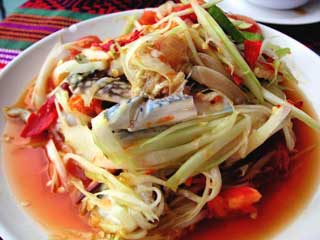
© Copyright 1995-2023, Clay Irving <clay@panix.com>, Manhattan Beach, CA USA
| | |
Recipe from: Colonel I.F. Khuntilanont-Philpott
Servings: 1
There is a joke to the effect that the dish called som tam is hot, but tam som is hotter, and tam lao the hottest of all. (These being the name of the dish in Bangkok and the Isan respectively, and a variant common to rural people in the Isan).
Be that as it may, this is the version common in the countryside of the Isan. Virtually everything about the variants of som tam is 'optional', except for the papaya. I would also point out that in the Isan the mud fish and the crab are typically raw, which leads to common warnings from the Thai government about hepatitis (from the crab), and intestinal parasites (from the mudfish). In line with this the following preparation is designed to avoid that problem.
 | The picture to the left is Som Tam at a restaurant in Thailand. This version was incredibly hot and spicy! It may actually be Tam Lao because it included raw crab. It is made with julienne strips of green papaya, prik ki nu (fiery Thai chiles), kratieum (garlic), raw crab, prik chi fa daeng (Thail jalapeño chiles), nam pla (fish sauce), long beans, Nam Manao (lime juice), and ma kua teet (tomato). Trust me. It made a grown man cry! -clay |
The number of chillies to include in the dish is the first order of business when ordering the meal — foreigners being well advised to say 'none' since the mortar and pestle aren't washed out between preparations and there is generally enough chilli juice left in the bottom for foreign tastes. Locals may sometimes order up to 30 chillies in a single portion, which renders the tam lao blood red, and has an affect in the mouth similar to fire! If making it at home I would suggest you start by trying 2 or 3 chillies ...
When not actually preparing the dish, vendors advertise their services by sitting julienning the papaya: they hold it in one hand whilst 'whacking' it with a cleaver in the other, pausing occasionally to shave off a layer of julienned fruit. This technique is even more remarkable when you see them carrying on a conversation with a neighbouring stall holder and not looking at the papaya as the razor sharp cleaver reduces it to a nubbin in their hand! I suggest that in the interests of safety you do not try to emulate this technique: slice off a thin piece of papaya, then cut it into matchstick sized pieces in a more normal fashion! The papaya should be crispy and firm in texture.
The crabs used in Thailand are small river crabs, about an inch across the body. If these are not available you can use any form of crabmeat. pla ra is available in small jars from Asian grocers.
1 cup papaya, julienned
1 tablespoon nam pla (fish sauce)
1 tablespoon nam tan paep (palm sugar)
1 tablespoon pla ra (pickled mudfish)
2 tablespoons nam manao (lime juice)
3 to 4 cherry tomatoes
1 to 2 makheua pro (thai eggplants or aubergine, cut in small balls)
1 tablespoon kratiem (garlic), roughly chopped
up to 30 prik ki nu daeng (red bird's-eye chillies), sliced.
Stir fry the crab, and then break it up and sprinkle liberally with vinegar, and season with freshly cracked black pepper. Allow to stand for about 1 hour before using.
Next julienne the papaya, and place it in a mortar and pestle.
Boil the mudfish in a quarter cup of water for 2 to 3 minutes, then transfer to a muslin bag and squeeze out as much juice as possible. (You may also include the fish, but this is not recommended, see warning above).
Finally quarter the tomatoes and the eggplant, and put all the ingredients in a mortar and pestle and pound to soften and bring out the juices.
Serve with a selection of fresh raw vegetables.